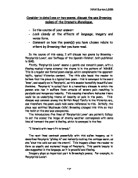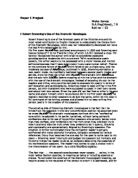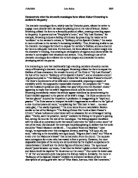The next lines contrast powerfully with this sullen imagery, as it describes Porphyria ‘’gliding in” and instantly making the cottage warm, as she “shut the cold out and the storm”. This imagery allows the reader to form an angelic and maternal image of Porphyria. This gentle beauty is also suggested in the language, as it is graceful and flowing.
Imagery plays an important part in Browning’s poems. For example, in ‘Porphyria’s Lover’:
“… and let the damp hair fall,
And, last, she sat down by my side
And call’d me. When no voice replied,
She put my arm about her waist,
And made her smooth white shoulder bare,
And all her yellow hair displaced,
And, stooping, made my cheek lie there…”
This usage of imagery depicts a semi-erotic, intimate and gentle scene, and creates a vividly ardent image in the reader’s mind. As the poem continues, it becomes clear to the reader that the love in the poem is illicit. A popular interpretation is that the man is a servant to Porphyria, and she is having an affair with him – and so cannot stay with him. He, however, contemplates on what he could do so that his lover can be with him eternally. He struggles with the realisation that “Porphyria worshipp’d” him.
The language becomes increasingly emotive, building up to a crescendo:
“Be sure I look’d up at her eyes
Happy and proud; at last I knew
Porphyria worshipp’d me; surprise
Made my heart swell, and still it grew
While I debated what to do.
That moment she was mine, mine, fair,
Perfectly pure and good: I found
A thing to do, and all her hair
In one long yellow string I wound
Three times her little throat around,
And strangled her. No pain felt she…”
Personally, I find this incredibly poignant and striking – Browning somehow conveys this brutal act of murder in a slightly disturbing yet beautifully moving manner. Browning’s choice of language aids this, as does the flowing style of the lines, with enjambment to represent how his feelings similarly flow on inexorably and uncontrollably. The murder is a complete shock to the reader, as no indication of the man’s intentions was expressed previously – most likely because he himself had not realised what he might do.
Once Porphyria is dead, the poet uses charming similes such as “as a shut bud that holds a bee” to describe her eyes. The simple, emotive lexis implies that he genuinely believes they can now be together forevermore.
‘Porphyria’s Lover’ uses the same kind of structure as ‘My Last Duchess’, another dramatic piece by Browning, with poignant meaning conveyed in a manner oblivious to the disturbing content. Many critics believe that Browning writes with the sole aim to shock the reader with disturbing topics and vivid imagery based on disconcerting themes such as murder, or corrupted church men – as seen in ‘Fra Lippo Lippi’ and ‘Soliloquy of the Spanish Cloister’.
The second dramatic monologue I will discuss is ‘Soliloquy of the Spanish Cloister’. This poem reflects the traditional English distrust of Roman Catholicism. It is written as a monologue spoken by a monk who detests another monk, Brother Laurence, and throughout the bitter poem, he describes his bestial hatred for him.
The opening line, “Gr-r-r- - there go, my heart’s abhorrence”, instantly starts with a colloquial snarl, and immediately expresses the monk’s total revulsion by Brother Laurence. He goes on to list various trivial and petty reasons for disliking him, which has a slightly comical effect as it would seem the monk was over-reacting. Heavily stressed lines indicate the force of his hate, for example:
“If hate killed men, Brother Laurence,
God’s blood, would not mine kill you!”
This reference to God’s blood is blasphemous, and therefore shows the lengths to which the monk will go to reveal his hatred. This wild attitude contrasts with the perfectly rhymed, punctuated format of the poem; this formal style makes the uncontrollable ferocity of his detestation seem even more overbearing. The content of this poem is similar to a book entitled “The Monk”, by Monk Lewis, which was around at the time of this poem’s publication, and it is possible that Browning drew some of his inspiration from this source.
The discourse structure is flowing, yet without any clear introduction – this effectively displays that the monk is incredibly furious and has no time to include niceties at the beginning of the piece. The poem is, however, clearly set out, and in each verse he demonstrates another reason he dislikes Brother Laurence, and what he wishes he could do to him. The final line of the piece uses the same colloquial, savage snarl that the poem opened with: “Gr-r-r- -“. This resembles how his hatred has not diminished throughout the duration the monologue.
Italics are used when Brother Laurence is quoted, and he is conveyed through this as a tediously dull, typical monk. The tone throughout the poem is sarcastic and colloquial, incorporating dark and twisted humour:
“How go on your flowers? None double?
Not one fruit-sort can you spy?
Strange! - - And I, too, at such trouble,
Keep them close-nipped on the sly!”
The imagery is vivid, representing the clear dislike for Brother Laurence, yet he often seems excessively pedantic:
“I the Trinity illustrate,
Drinking watered orange-pulp- -
In three sips the Arian frustrate;
While he drains his at one gulp.”
This is a biblical reference to the Trinity consisting of three forms, and the monk suggests maliciously that because Brother Laurence does not drink in three sips, he has no respect for the Trinity and is an immoral monk. He is trying to slur his Brother’s saintly image, and does so again, when the poet insinuates that he fancies local women by using vivid sexual imagery to describe them – however this only seems to imply that the poet himself has a liking for them.
The trivial topics raised by the monk in ‘Soliloquy of the Spanish Cloister’ are amusing to the reader because it contrasts with any reader’s previous knowledge of the temperament of monks – this is a typical device used to illustrate humour in written texts, and Browning has made full use of it in this piece.
‘Soliloquy of the Spanish Cloister’ is similar to ‘Porphyria’s Lover’, because in both poems Browning has used flowing lines and enjambment to indicate the overflowing emotions the speaker is feeling, although the latter poem uses romantic, idyllic lexis compared to the incandescently angry vocabulary and content of ‘Soliloquy of the Spanish Cloister’. This poem has overly stressed lines together to give the effect of punchy anger, whereas ‘Porphyria’s Lover’ has formal, evenly stressed lines to suggest the placid, calm attitude of the man.
In conclusion, Browning makes effective use of language, structure and imagery in all of his Dramatic Monologues – using similar styles in each but varied to reflect the mood and tone of each individual poem.







